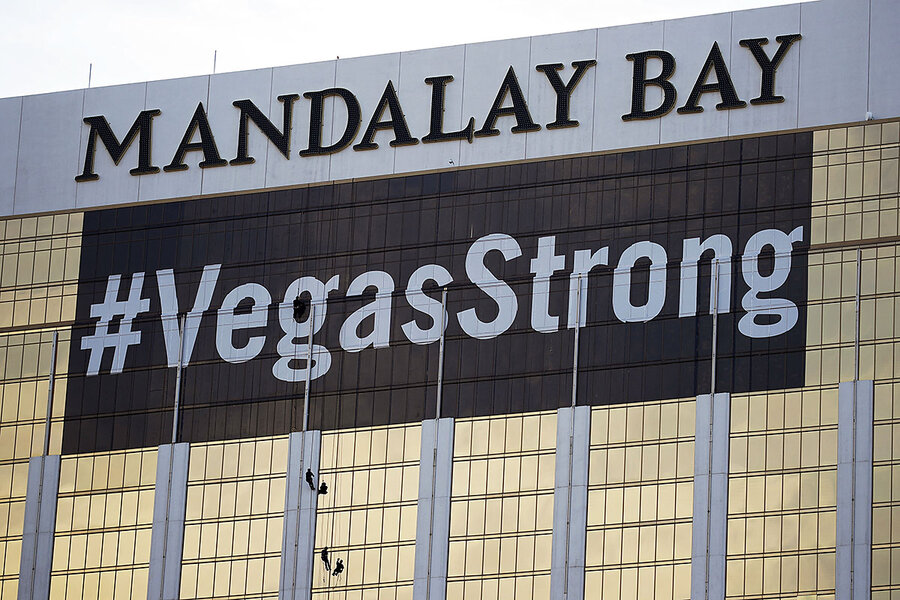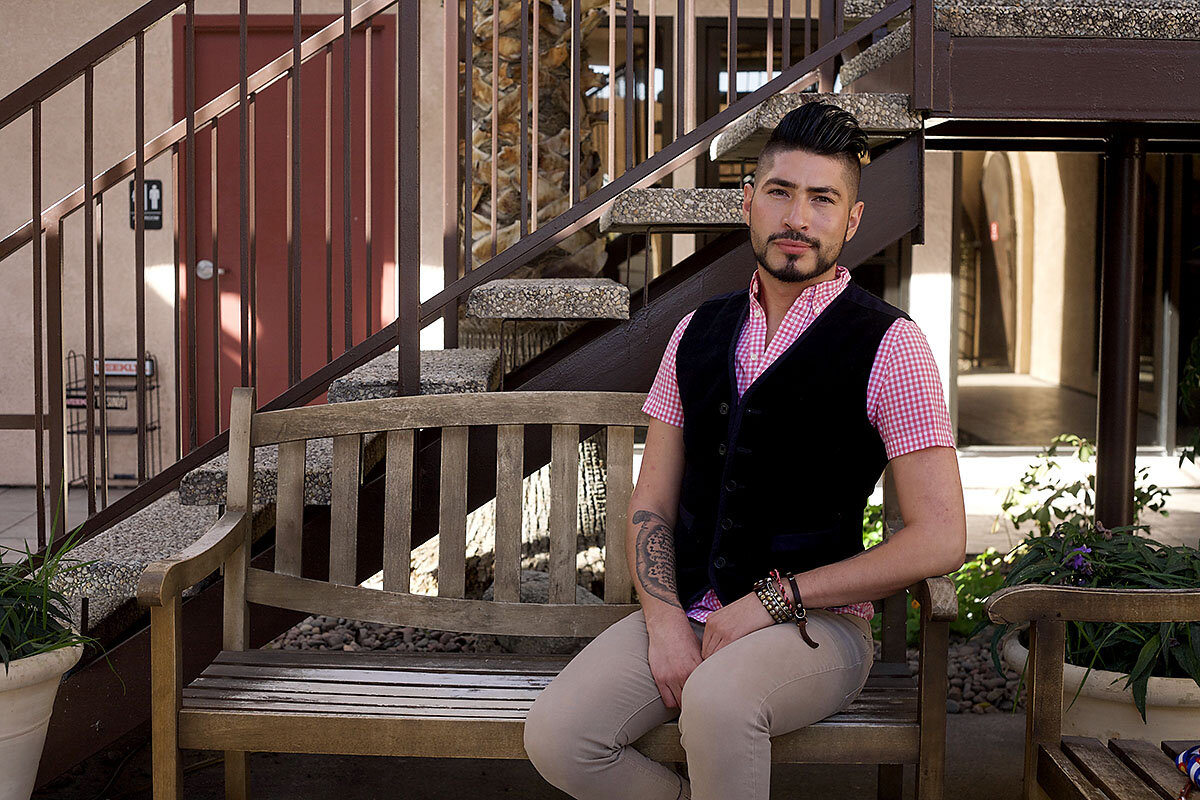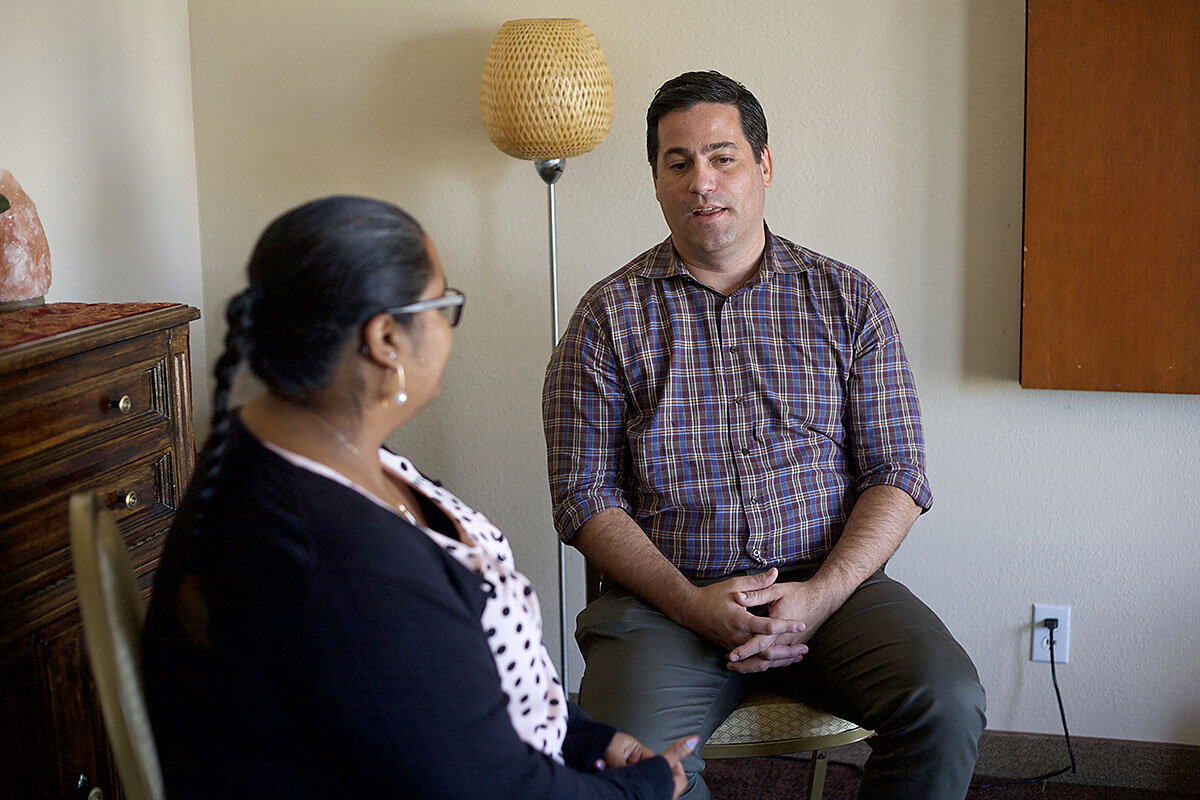After Mandalay Bay, Las Vegas grapples with how to heal together
Loading...
| Las Vegas
For a week after the shooting, Christopher Mendoza thought he was fine.
A wellness counselor for HIV-positive individuals at a Las Vegas nonprofit, Mr. Mendoza focused on his clients’ needs in the days following the Oct. 1 tragedy, when Stephen Paddock opened fire on a crowd attending a concert outside Mandalay Bay. “Everyone that walked through my door client-wise needed to talk and just unload,” Mendoza says. “I tried just giving them positive thoughts: ‘It’s OK to leave your house. You're safe. This is your home. Do not be afraid.’
“I don’t think I believed it myself.”
That became clear the Saturday after the shooting, when Mendoza found himself yelling at a stranger at a local bar. The man had made some flippant comment about the event, he recalls. “I kind of blew up on him,” says Mendoza, who left the bar in tears. “I guess you could say I finally broke.”
The massacre in Las Vegas was among the deadliest mass shootings in US history, with 59 people killed. The incident has revived debate over issues such as gun control and the definition of terror. But experiences like Mendoza’s – recounted in support groups and therapy sessions across the city in the weeks following the tragedy – speak to another concern: how to help members of a community cope with a traumatic event.
“Often we frame [mental health] as looking at what happens to individuals,” says Arthur Evans Jr., chief executive officer of the American Psychological Association (APA). That’s important, he says. But it’s just as crucial to examine how mass shootings and terror attacks affect survivors, families of victims, first responders, and the community at large – and come up with strategies to help.
“Are there things we can do to mitigate the likelihood that people will get post-traumatic stress disorder, or other symptoms [after a mass trauma]?” asks Dr. Evans. “It’s a different way of thinking about it.”
Coming together after tragedy
The night of the shooting, Mendoza gave his longtime partner, who was visiting from Colorado, a tour of Mandalay Bay. They wandered for an hour around the same tower from which Mr. Paddock would rain gunfire into a crowd of 22,000. They planned to have a late dinner at the hotel but decided they were too tired. They went back to Mendoza’s place, a five-minute drive away.
Their phones started going off as soon as they walked in. Worried messages poured in from Mendoza’s family in California. Their social media accounts began blowing up with news of the shooting. From the backyard of his home, Mendoza could see Mandalay Bay – and hear the police sirens and screams. He kept trying to reach friends who worked on the Strip. Nobody slept.
He took the next day off work, but by Tuesday Mendoza was back at his office at the Community Counseling Center of Southern Nevada, helping clients process the horror of Sunday night.
On the one hand, it was a testament to the city’s resilience. Across Las Vegas, locals like Mendoza stepped up to the aid of survivors and fellow residents. They gave time, money, food, even blood. Volunteers built a memorial garden downtown. Dozens of clinics and wellness centers, including Community Counseling, offered free support groups and therapy for anyone who felt they needed to unload. “It was really, really amazing to see the city come together so fast,” says Mendoza (who is no relation to the reporter).
But the city’s response also highlighted the gaps in support in the wake of a mass trauma – and the need to be better prepared. Community Counseling saw its resources stretched thin, as staff worked overtime to accommodate people's needs. Others found it more difficult to get the word out that they were offering services. “We could have had and we can have more people come to the sessions we're offering,” says Asher Adelman, chief executive officer of Alta Wellness Center, just west of downtown. “How do we get these resources into the hands of people who need them?”
Even those in the mental health field weren’t entirely prepared. Mendoza says that after what he calls his meltdown that Saturday, he has made an extra effort to take care of himself so that he can better attend to his clients. Ronald Lawrence, founder of Community Counseling, was called in to a local hospital the day after the shooting to provide support to doctors and nurses on duty at the emergency room that night.
Mr. Lawrence has provided counseling for first responders before. Still, “I was just unable to eat the rest of that day,” he says. “It was too hard.”
An action plan could help address some of those gaps in mental health services and capacities, says Evans at the APA. “Communities come together really well, but you’re not going to be as effective as if you organize prior to these events,” he says.
Creating a 'trauma-informed community'
For the most part, the mental health community has focused its efforts on treating trauma in individuals – victims of sexual abuse, for instance, or survivors of car accidents.
The Sept. 11 attacks began to change the conversation, as mental health researchers and practitioners started to recognize the long-term effects, not just on individuals, but on communities. Terror attacks and mass shootings violate people’s sense of safety and security – sometimes for years, says Yuval Neria, professor of medical psychology and director of the PTSD research program at the Columbia University Medical Center in New York.
Yet the response to such events today still essentially mirrors what happened after 9/11, Professor Neria says: “There was a massive surge of money and attention early on, and then people were left to their mental health issues with a handful of mental health professionals to deal with them. That’s not the way to deal with mass trauma.”
Some communities have tried to develop more proactive approaches. After the 2011 massacre of 69 people at a summer camp on Utøya Island, Norway – about 25 miles northwest of Oslo – mental health professionals and municipal crisis teams contacted survivors as well as bereaved families to gauge how well they were doing. They were screened, provided a contact person, and those who showed signs of risk for mental health issues were connected to specialized services.
Studies later showed that the strategy not only provided targeted support to the people who needed it most; it also gave researchers a fuller understanding of how mass trauma affects those who are indirectly exposed.
Closer to home, in Philadelphia, Evans, the city's former commissioner of behavioral health, worked with local mental health professionals to train lay people to identify signs of mental health challenges and connect others to existing resources. They brought in trauma experts to hospitals so that survivors of, say, gang shootings could be treated both physically and mentally. They organized community art projects and hosted events to educate the public.
“We were trying to create a trauma-informed community and heighten the understanding of these issues ... and build capacity in community institutions,” Evans says. The hope was that the city would be primed to face not only the daily difficulties of dealing with mental health issues, but also those that might come with a mass traumatic event.
Opportunity for change
Though they are gaining ground, such efforts face considerable challenges. Most cities and states already struggle to provide basic health care for their constituencies. When resources are scarce, attention often goes to the worst and present cases – leaving little left over for precautionary measures, Evans and others say. Also, while there’s less stigma around mental health, treatment is still viewed mostly as a personal rather than a societal issue, even by many in the field.
But probably the biggest obstacle to preparing communities to deal with trauma are the communities themselves.
“A community often has to be directly impacted in order to take things seriously,” says Charles Figley, a professor who specializes in disaster mental health at the Tulane University School of Social Work in New Orleans. “We don’t want to think about the possibility of our community experiencing a disaster that we have to prepare for.”
Which is why a tragedy like the Las Vegas shooting is an opportunity for change.
Patrick Bozarth, executive director at Community Counseling, feels optimistic. “Agencies like ours are becoming more trauma-informed and focusing on crisis intervention,” he says. “I think that’s going to just continue and I think that’s a really good result of such a horrible tragedy.”
Still, the going is likely to be slow. Mendoza points out that, like him, some residents are only just coming to grips with what happened. Even now, three weeks after the fact, he still tries to avoid Las Vegas Boulevard. “It still gets me shaky, just talking about it,” Mendoza says. “It’s not something you get over overnight. We’re all still working through it.”








